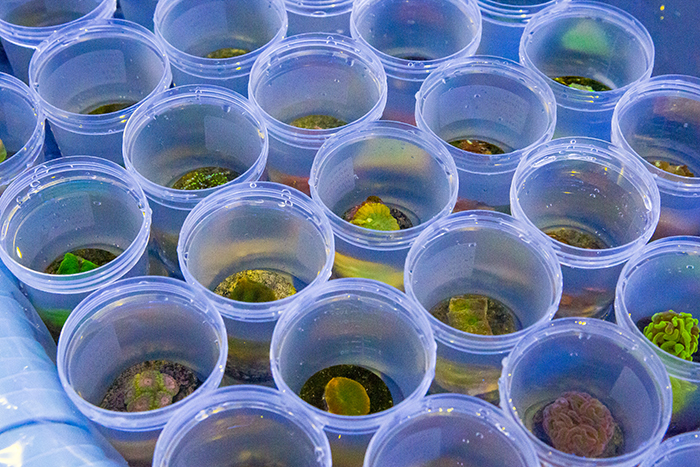
Shipment preparation at Eye Catching Corals. Flat coral frag discs are a near perfect match for the bottom of the specimen containers, reducing movement during transit.
Fighting to Replace Single-Use Plastics
By Matt Pedersen with images by Klynt Maston
Excerpt from CORAL, March/April 2019
Our planet’s addiction to single-use plastic products that spawn seemingly immortal pollution is now becoming a trending social media meme and gaining in widespread public awareness. By some estimates, oceanic plastic is projected to outweigh all the fish in the seas by the year 2050. Eliminating plastic shopping bags, ending our reliance on throwaway water bottles, and giving up plastic straws are all steps people and communities are taking in an effort to eliminate this scourge. What about the aquarium trade?
In our own backyard, single-use plastic bags are generally utilized at every stage of the marine aquarium livestock trade supply chain. Fish and coral are often individually double- or tripled-bagged, utilizing bags generally made from clear, low-density polyethylene (LDPE, recycling #4). While these bags are considered a “safe” and recyclable form of plastic, most often they are destined for the trash. Each fish or coral arriving to the end consumer could possibly represent the use of 10 or more bags as it changes hands from collector to exporter to distributor to fish shop to your tank. Is there a better way?
Eye Catching Coral (ECC), an importer, wholesaler, and coral farm based in Vienna, Ohio, believes plastic bags aren’t always the best solution. Founded in 2007, the company grew to occupy a 4,000-square-foot aquaculture facility by 2016. One of the company’s mainstay offerings is a subscription-based shipment of coral frags which is prepared monthly for aquarium retailers around the U.S. Thousands of aquacultured corals, some of which are first-generation cuttings of wild imports and others that are from multi-generational parent stock grown in landlocked Ohio, all need to be packed safely and efficiently for their journeys.
ECC’s CEO, Jim Gintner, explained how they’ve saved money and dramatically reduced their plastic waste by shipping their aquacultured products in reusable screw-top plastic containers. “We have been using specimen containers and bags on and off throughout our company’s 12 years in business. Two years ago we made the commitment to only ship frags in these containers, and we have not looked back since. I have seen others do this, but not on a large commercial level. We were not the first to ship a frag in a specimen container, but I feel we are the first to do it at this volume.”
ECC suggests there are sufficient cost savings and other benefits with their use of these polypropylene containers (PP, recycling #5). “Shipping our coral frags in specimen containers instead of bags has saved us a substantial amount of time and money,” says Gintner.
For the layperson reviewing publicly available pricing online, bulk purchases of traditional fish bags may make them appear cheaper initially; retail price points suggest that double-bagging a coral frag might cost $0.10 for bags and rubber bands, whereas the specimen containers might cost closer to $0.15 each. However, Gintner reports that, by purchasing at scale, their cost in specimen containers is approximately 8 cents. “Conversely,” he says, “bag costs, including labor to double-bag them or add liners, ranges from $0.08 to $0.35 per ship-ready bag.” An even larger savings comes from vastly improved pack-out times: Eye Catching Coral’s round, flat-bottom frag disks are a near-perfect size match for the bottom of the cup; team members can simply place the frag into the cup and screw the lid on tightly.
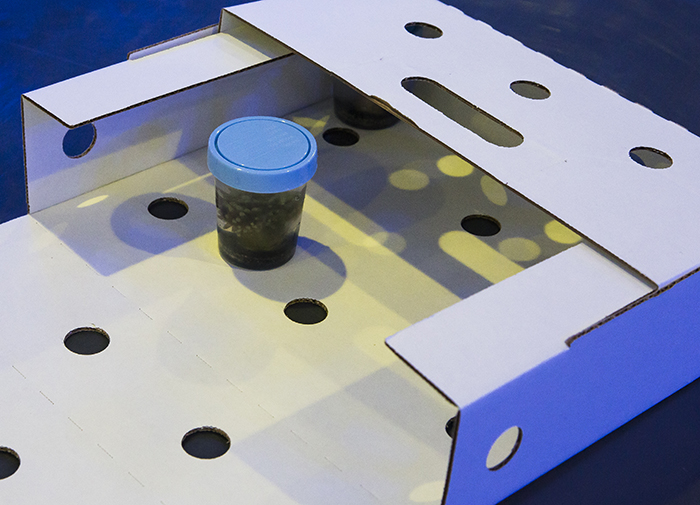
The uniform dimensions of specimen containers fit well into standard packing boxes and making forecasts of dimensions and shipping weights extremely easy.
Packing shipping boxes is a breeze, given the uniform size of each coral frag disk and its container, which results in easily calculated, uniform shipments. “The consistent size allows us to forecast space and weight for each shipment,” notes Gintner. ECC also knows that their corals move around less during transit and they aren’t able to puncture their shipping container, eliminating transit losses that could otherwise occur with traditional fish bags. “Our custom frag bases fit almost perfectly into the bottom of the cups, so there is very little (if any) movement. The frag disk base keeps the coral secure and keeps it from moving around to hit the sides; we see very little coral breakage. When putting corals in bags, it is rarely a perfect fit; there is much more movement and potential for damage.
“More importantly, using specimen cups helps to cut down on waste,” concludes Gintner. “Our retailers are also able to reuse the containers when selling these frags to the hobbyist. We also have seen hobbyists reuse the containers for many useful things, such as coral transportation to frag swaps or club meetings, thawing food for fish or corals, acclimating, dipping, storage, and more.”
ECC still utilizes traditional fish bags for larger corals and fish shipments, but they’re always on the lookout for a better solution. “When we do use bags, we employ a local, community-based facility that gives jobs to people with disabilities or special needs. We give them the raw bags and they charge us a small fee to double- and triple-bag them and add liners. It is another rare win-win as we help the local community.”
“Daily improvements are very important to us as a company,” Gintner says. “If we don’t look back and laugh at how much better things are today than they were a year ago, then I do not think we are improving fast enough.”
Read more:
Eye Catching Coral (wholesale only):
https://eyecatchingcoral.com/
Online: Nat Geo/Ocean Plastic
https://www.nationalgeographic.org/education/ocean-plastic/
If you enjoyed this story, be sure to subscribe to CORAL Magazine to never miss an issue!

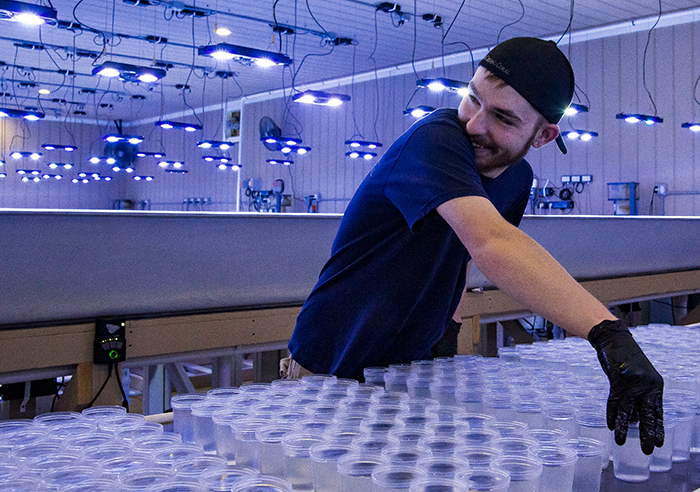
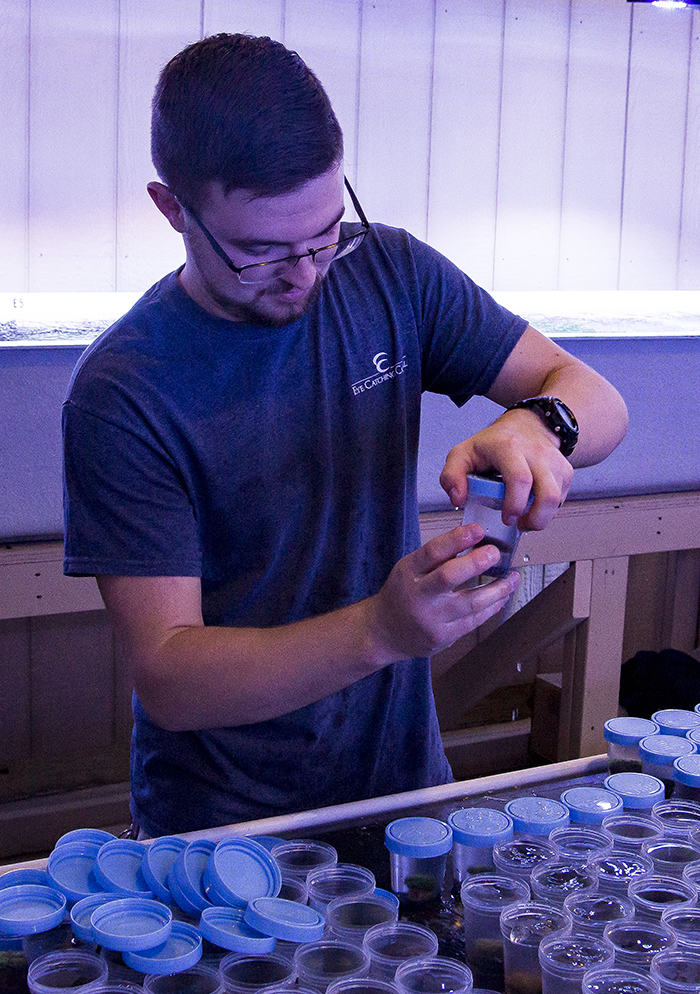
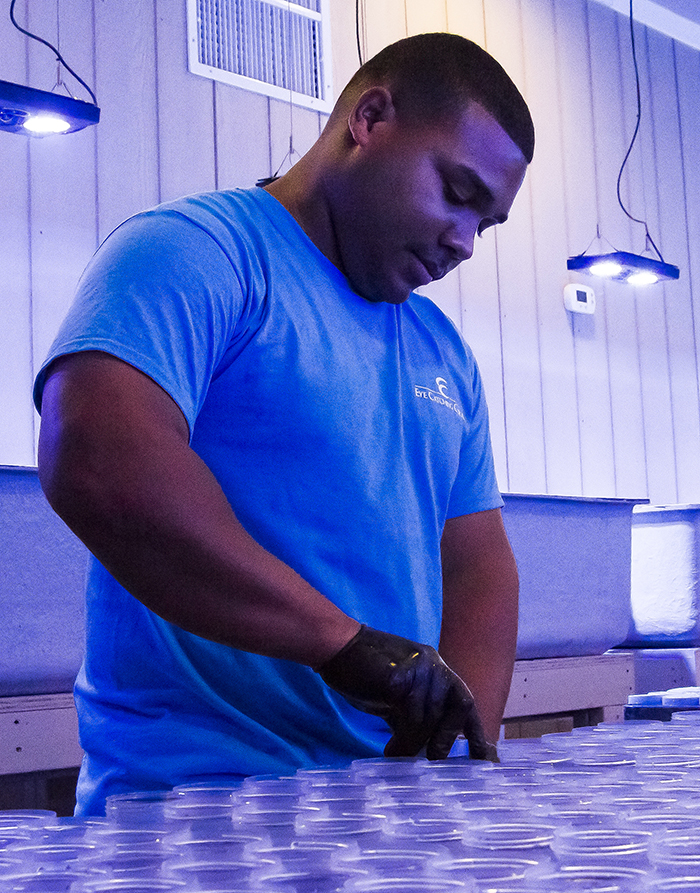





I owned 2 LFS in the 90s and early 2000 and i always saved bags to reuse from shippers on fish and coral delivery s by doing that my overhead was cut down but the amount of plastic bags and rubber bands a single LFS use’s in a year is unreal and the amount that goes from collection to customer is down right astonishing in a years time I also worked at a transhipper where we rebagged and put fresh water in fish bags from plane to store the amount of bags is absolutely staggering so great job using speciman cups What is the effect of rubber bands on the earth because so many are used
Abrolhos Coral and live rock has used sterile specim jars to transport live coral around Australia for the last 3 and half years .They are an excellent packaging solution and many ot my retailers encourage consumers to keep reusing the jars -see us on fb or insta at Abrolhoscoral